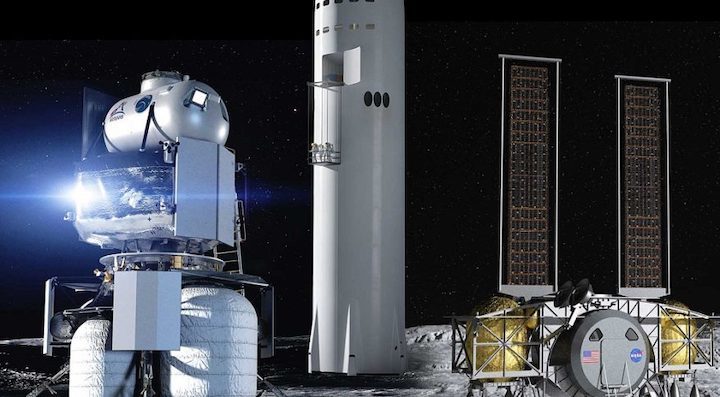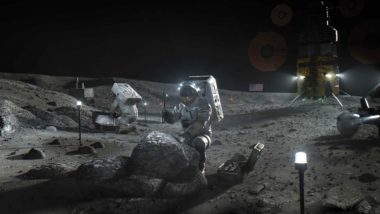18.06.2020

In about four and a half years, NASA envisions a lunar lander touching down near the south pole of the moon. Two astronauts will exit the lander’s crew module and go down a few steps to be the first humans on the lunar surface since 1972. Or, they’ll make their way down a much longer ladder to the surface. Or maybe just take an elevator.
NASA looked to tap into the creativity of the private sector with its Human Landing System (HLS) program to develop the landers needed for the Artemis program. Rather than use a conventional contracting approach and pick a single company to develop a lander under a cost-plus contract, it offered multiple fixed-price awards to companies that would develop landers though public-private partnerships, with NASA eventually being one of potentially several customers for them.
“This is the last piece that we need to get to the moon, and now we’re going to have that under development,” NASA Administrator Jim Bridenstine said during an April 30 teleconference where he announced the winning companies. “Today, we’re going under contract with three companies that are going to take us all the way to the moon.”
Despite his confidence, though, there remain many questions about whether any of those companies will be able to have a lander ready in time to meet the Trump administration’s goal of a 2024 landing, or if NASA will have the budget to afford them.
THREE DIFFERENT LANDERS
When NASA released the final version of its HLS call for proposals last September, the agency outlined a two-phase approach for developing lunar landers. NASA would first pick as many as four proposals for an initial round of studies, advancing designs to the equivalent of a preliminary design review over about 10 months. NASA would then select one or two companies for full-scale lander development, with one being ready to support a 2024 landing, while the other would take a slower development track for a mission in 2025 or later.
NASA selected three of the five proposals it received for those initial studies. The largest single award, $579 million, was also perhaps the least surprising. Blue Origin announced its intent to compete for the HLS program in October, with company founder Jeff Bezos announcing a at the International Astronautical Congress in Washington a “national team” that features Draper, Lockheed Martin and Northrop Grumman.
The lander design NASA selected for further development closely follows what Blue Origin described last fall. Blue Origin will provide the descent stage, based on its Blue Moon cargo lunar lander concept and powered by the BE-7 engine it is developing. Lockheed Martin will build the ascent module that includes the crew cabin, leveraging systems it created for the Orion spacecraft. Northrop Grumman will build a transfer module, based on its Cygnus spacecraft, that will move the lander from the Gateway and Orion’s elliptical halo orbit around the moon to low lunar orbit. Draper will develop the lander’s avionics and software.
Dynetics, which received a $253 million award, took a lower profile in more ways than one. The company didn’t acknowledge that it bid on HLS until January, after Sierra Nevada Corporation executives said in a media call it had collaborated with Dynetics on a proposal. The company said little more at the time beyond that it had assembled “a very impressive team of experienced small and mid-sized companies” for its bid. That turned out to be a group of 25 companies that included Maxar, Thales Alenia Space, L3Harris and even one of Blue Origin’s teammates, Draper.
Dynetics offered a distinctive lander concept that won praise from NASA reviewers for its “crew-centric” design. Rather than have the ascent module, with its crew cabin, stacked on top of the descent module, like Blue Origin’s design as well as the Apollo lunar lander, the Dynetics lander consists of a single module ringed by propellant tanks, using the same engines both for landing and takeoff. That allows the module to be low to the ground, requiring just a few steps to get from the lander to the surface.

The third winner, SpaceX, never announced that it was bidding on the HLS program, although most in the industry were not surprised they competed. As many surmised, SpaceX offered a version of its Starship vehicle as a human lunar lander that NASA selected for a $135 million award. SpaceX had already offered Starship to NASA’s Commercial Lunar Payload Services (CLPS) program for landing robotic payloads, although the company has yet to win a CLPS task order for a lander mission.
SpaceX’s approach would involve several different Starships, including one that would be a propellant depot in low Earth orbit, fueled by tanker Starships. The lunar lander Starship would launch to Earth orbit and fill its tanks at the depot before departing for the moon. The Starship lunar lander is far larger than the alternative concepts, and its crew cabin is so high that astronauts will need to use an elevator to get to the surface.
Notably absent from the winners was Boeing, which announced in November it proposed a lander that could launch as a single, integrated vehicle on a Space Launch System rocket. It argued that its “Fewest Steps to the Moon” concept minimized complexity over concepts that required aggregating two or three lander elements, launched individually, at the lunar Gateway.
NASA’s source selection statement for the HLS program did not explain why Boeing failed to win an award, only that it was removed “from further consideration for award earlier in the source selection process.” (That document also disclosed NASA received a bid from a fifth company, Vivace, best known as a manufacturer of tanks and structures; it, too, was excluded from consideration without explanation.)
“Boeing does not discuss its technical proposals or evaluations,” Boeing spokesman Jerry Drelling said.
INNOVATION VS. SPEED
NASA went to great lengths to emphasize the innovation the three companies, with their very different concepts, offered to the agency. “One thing that we were striving for,” said Lisa Watson-Morgan, NASA HLS program manager, “is to see what U.S. industry could bring us with respect to innovation. And boy, did they deliver.”
“In summary, all three offerors proposed audacious and innovative HLS designs and capabilities, each with unique technical merit,” NASA Associate Administrator Steve Jurczyk wrote in the source selection statement. “Many of the technologies upon which these capabilities rely have yet to be developed, tested, or demonstrated; the challenge that lies ahead is formidable.”
Those comments, though, highlight the tension in the HLS program between that desire for innovation versus the schedule challenge of getting humans back to the moon by 2024. Development of new technologies is subject to delays and setbacks, not the mention the risk of just not working at all.
That schedule risk emerged as a major issue in the evaluation of the proposals. NASA cited as weaknesses in SpaceX’s bid the complicated architecture involving many Starships and a “notably complex” propulsion that has little schedule margin to accommodate delays. “These development and operational risks, in the aggregate, threaten the schedule viability of a successful 2024 demonstration mission,” NASA noted in the source selection statement.
The reviewers also warned about SpaceX’s past performance, such as multiyear delays in development of Crew Dragon and Falcon Heavy, that reduced their confidence “in SpaceX’s ability to successfully execute on its proposed HLS development schedule.”
NASA raised similar issues about the other two winners. Blue Origin’s power and propulsion system is technically immature, the statement concluded, and requires “a very significant amount of development work that must proceed precisely according to Blue Origin’s plan, including occurring on what appears to be an aggressive timeline.”
The same system on Dynetics’ lander “introduces appreciable risk of unsuccessful contract performance from both a technical and development schedule standpoint,” the statement argues, in part because it relied on unproven technologies that “would need to be developed at an unprecedented pace.”

NASA was asked at the announcement how it could make that 2024 deadline since it has less time than in the 1960s with the Apollo lunar lander, which took about six and a half years from contract award to the Apollo 11 mission.
“We have technologies that exist today that had to be invented back in the ’60s. We don’t have to invent technologies today to make this work,” said Doug Loverro, NASA associate administrator for human exploration and operations, contradicting the assessment NASA made in its review of the proposals.
He said a bigger factor was getting the requirements right. A change in requirements created a two-year delay between the preliminary and critical design reviews of the Apollo lander, he argued. Getting those requirements right will be a primary focus of the first few months of each HLS contract. “An extra month that we take in the very beginning to make sure that we have the requirements right will save us a year on the back end.”
AN EXTRA PUZZLE PIECE?
Loverro, like Bridenstine, saw the HLS awards as finalizing its plans for returning humans to the moon. “We are now on our way,” he said. “There are no hurdles left. There are no more puzzle pieces to add.” The Artemis program, he said, had everything it needed to land humans on the moon. For the 2024 landing, though, NASA may instead have an extra piece. Its original plans called for using the lunar Gateway as a base camp for those lunar landing missions, a facility where both the lunar lander and Orion would dock.
In March, though, Loverro told a NASA advisory committee that he was taking the Gateway off the critical path for a 2024 landing but preserving its development for later missions. Bridenstine confirmed that plan at the HLS announcement. “The Gateway is not required for that 2024 mission, and, in fact, I would go as far to say that it’s not likely that we will use the Gateway for the 2024 mission,” he said.
Gateway remains important for NASA’s long-term plans for sustainable lunar exploration, he emphasized. But, he added, “anything that is not necessary we need to move out of the way so that we can get to the surface of the moon” by 2024.
Loverro said that Gateway may yet serve a supporting role for the 2024 mission. “It’s still going to serve as a communications hub,” he said. “It’s going to be our high-bandwidth communication back from the surface of the moon for 2024.”
A GIANT FUNDING LEAP
The three HLS awards have a combined value of $967 million. However, the contracts are only a down payment for building one or more landers, which is likely to cost NASA several billion dollars plus whatever contributions the companies in the program make as part of the partnership.

NASA, anticipating that cost, requested a nearly 12% budget increase in its fiscal year 2021 budget proposal in February. However, the federal government’s response to the coronavirus pandemic, including more than $2 trillion in supplemental spending bills, has created doubts that Congress will be willing to support that increase.
Bridenstine was optimistic. “I don’t see our budget being cut because of this,” he said at the HLS announcement, discussing how he talked in the days leading up to the awards with members of the House and Senate of both parties.
“They have all been very supportive of the effort to get to the moon,” he said, “and I have not heard anybody suggest that, because of the coronavirus pandemic, we’re going to have to cut NASA.”
But not everyone in Congress backs NASA’s lunar lander plans. In a statement the day after the announcement, Reps. Eddie Bernice Johnson (D-Texas) and Kendra Horn (D-Okla.), chairs of the House Science Committee and its space subcommittee, respectively, criticized NASA’s approach to the Artemis program in general and lunar landers in particular. They introduced, with their Republican counterparts, a NASA authorization bill in January that called for a more traditional development approach for the lander.
“The multiyear delays and difficulties experienced by the companies of NASA’s taxpayer-funded commercial crew program — a program with the far less ambitious goal of just getting NASA astronauts back to low Earth orbit — make clear to me that we should not be trying to privatize America’s Moon-Mars program,” Johnson said.
Bridenstine was undeterred. “I don’t think we’re in any danger,” he said during a May 5 webinar hosted by the Center for Strategic and International Studies, making the case for including NASA in any infrastructure stimulus bill Congress may consider later this year. “There’s strong bipartisan support for the Artemis program.”
But the giant leap in funding needed for Artemis may yet turn out to be a bigger obstacle than the technology needed for lunar landers that will allow astronauts to make the next small steps on the moon in 2024.
Quelle: SN
